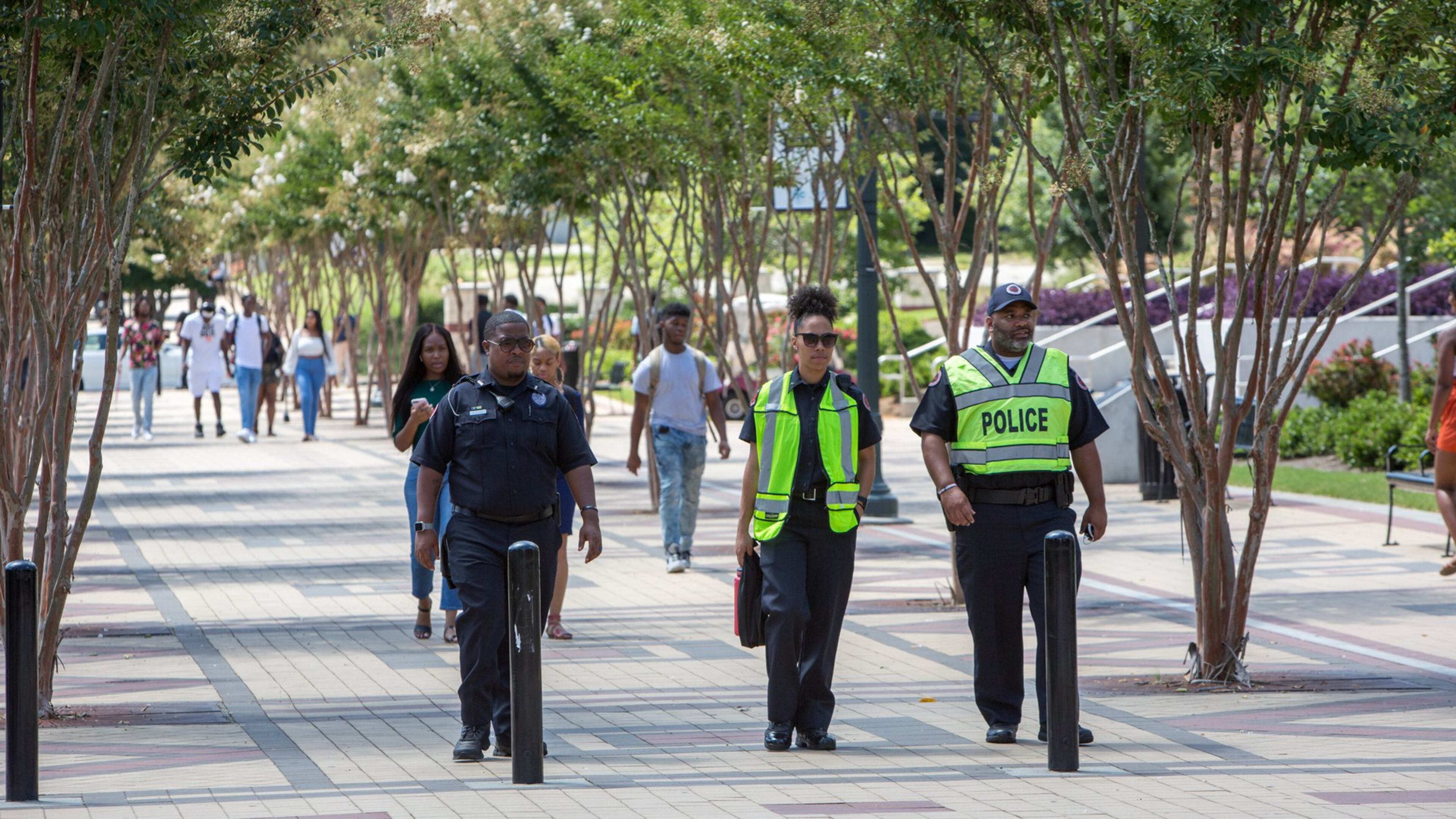Shock, comfort and safety concerns on Atlanta campuses after shooting

On Wednesday, the first day of school at Atlanta University Center, students walked past the place where a shooting had occurred hours earlier near the Robert W. Woodruff Library. Largely focused on their return to class, some joyfully reunited with friends they hadn’t seen since the prior semester. But for others the mood was subdued.
“You can just tell today that something’s a little off,” said Kyle Hobson, a junior political science major at Morehouse College. “The first day of classes, usually you’re excited to see everybody. Today it’s a little weird.”
“Everybody is shocked,” added Brooklyn Scott, 20, a Clark Atlanta University junior.
On Tuesday night, the first day of the school year was just hours away. So, for many students it was a night to dance and reconnect with classmates at a “pop up” party on the promenade near the Clark Atlanta campus.
The festive atmosphere changed at about 10:30 p.m. when shots rang out. Four female students were wounded — two from Clark Atlanta and two from Spelman College. The injuries were non-life-threatening, authorities said, and the students were not intended targets. Atlanta police released surveillance video Wednesday afternoon of a man they believe to be the shooter.
Police later identified the four students as Erin Ennis, 18, of Powder Springs; Maia Williams-McLaren, 18, of Boston; Elyse Spencer, 18, of Rochester, N.Y.; and Kia Thomas, 19. Thomas’ hometown was not provided.
On Wednesday, campus leaders attempted to comfort and reassure students and their families that the area is safe. But many students said the shooting exposed the need for tighter campus security on the streets near the university.
“Anyone can get on this campus,” said Clark Atlanta sophomore Jasmine Phelps, who is from Seattle.
The schools are part of a cluster of historically black colleges and universities — situated near downtown Atlanta and southwest of Mercedes-Benz Stadium — known as Atlanta University Center.
Several hundred students attended meetings on Clark Atlanta and Spelman campuses on Wednesday. The Atlanta Journal-Constitution was not allowed inside the meetings convened by administrators. Both schools are private. The schools released statements about the shooting, but did not grant requests for interviews or provide information about the victims.
For many, the shooting heightened the current anxiety about mass shootings and gun violence. Gov. Brian Kemp and Atlanta Mayor Keisha Lance Bottoms released statements about the incident and asked for prayers for the victims. Students said they received scores of telephone calls and messages from worried family members and friends. Clark Atlanta police appeared to be on every intersection of the campus Wednesday.
Tuesday night’s celebration was organized by a third-party promoter but was not sanctioned by any of the Atlanta University Center campuses, officials said. The group has organized several parties for Atlanta University Center students in the past, typically off campus in homes, and those parties weren’t violent, students said. Efforts to contact promoters involved in organizing the party were unsuccessful Wednesday.
Videos posted on social media showed students scrambling from the gunfire. Several relayed thankful accounts of their decisions not to attend the party. Others praised classmates who helped the wounded, like Clark Atlanta student Derrick Daniels, who took off his shirt and tied it around the leg wound of a Spelman student he hadn’t met before.
“I saw a young woman who needed help and I helped,” Daniels, 19, told the AJC.
About 8,000 students attend the three largest campuses in the center, Clark Atlanta, Morehouse and Spelman colleges. Three additional schools — Morehouse School of Medicine, the Interdenominational Theological Center, and Morris Brown College, which is seeking to regain its accreditation — are nearby. Most proudly share bonds of attending historically black colleges with legacies dating to Reconstruction. They also share a desire to support each other, engage in social activism and defend their schools.
Several students quickly said Wednesday the shooter was likely an outsider.
“It was somebody from the street,” said Clark Atlanta junior Micah Lee, who chose not to attend the party.
Clark Atlanta student LaTroya Goslee was worried the shooting would reinforce what they say are unfair stereotypes about crime on black college campuses.
“It’s unfortunate it has to happen at a HBCU,” said Goslee, 26, who is studying social work and lives off campus.
Still, she is concerned about her safety. Goslee said she’s hesitant right now to go to the library.
“Until they get it cleared, I won’t go,” she said.
Security has been a concern at college campuses throughout the city. Two years ago, the Atlanta University Center schools and the city government spent about $700,000 on security cameras and license plate readers on the campuses.
The school presidents are working together to review safety measures for the entire community, Spelman’s president said in a statement. Student leaders at Morehouse and Spelman said in statements Wednesday they plan to talk about ways to improve campus safety with administrators.
“We hope that you also join us in advocating for more efficient emergency responses, active shooter scenarios, and open conversations about safety throughout the year,” Spelman student government officers said in a statement. “In times like these we are reminded of our commitment to solutions that embody care, compassion and collaboration.”
Staff writers Christian Boone, Jennifer Brett and Shelia Poole contributed to this report.



